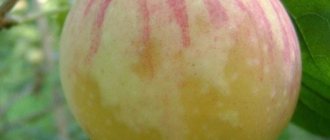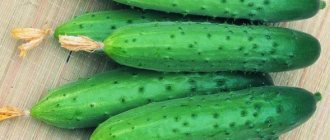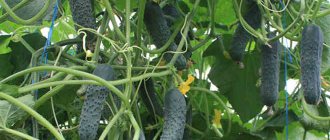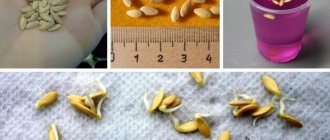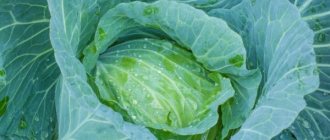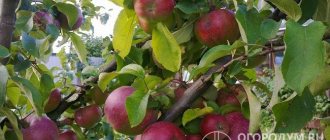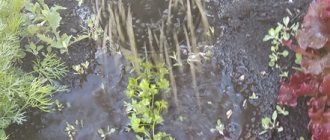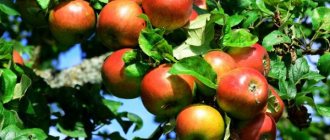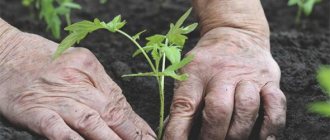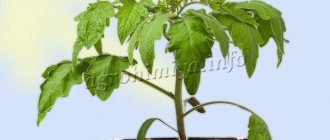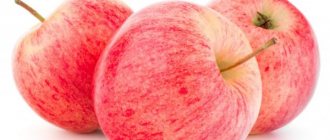Northern gardens do not have such high capabilities as Southern ones. The favorable climate is conducive to growing almost any apple crop. But in cold regions the possibilities are limited. Breeders are constantly working to create resistant varieties, one of which is Podarok Grafsky.
Apple tree variety Gift to Grafsky.
Characteristics of the variety
Podarok Grafsky apple trees are similar in description to many northern winter varieties. But there are a number of differences that make it in demand and popular.
Advantages and disadvantages
The Podarok Grafsky apple tree has many advantages over other varieties. You need to pay attention to:
- very high frost resistance;
- good immunity to apple diseases and many pests;
- unpretentiousness and the ability of the apple tree to adapt to various climate and terrain conditions;
- regular abundant fruiting;
- long shelf life without loss of taste and appearance.
Among the disadvantages, it can be noted that in the southern regions it will be necessary to increase the amount of watering, because the apple tree does not really like drought.
Tree height
The apple tree grows tall and fast. Already in the fourth year after planting, the height can reach 7 meters. But this indicator is achieved only without formation.
Crown width
The crown has a spreading, obverse shape. With proper care, it reaches 4 meters in width.
Annual growth
The annual growth rates are very intensive. In the first years it can reach 120 cm, and in an adult tree it stops slightly, up to 100 cm per year.
Productivity
Yield indicators are large; they may differ from year to year, but only slightly. The average yield from one mature tree is 250 kg.
Self-fertility
The apple tree does not have the properties of self-fertility. For the appearance of ovaries, it needs pollinating varieties nearby. They should bloom at the same time as the Gift.
Tasting assessment
Apples of the Podarok Grafsky variety earned 4.3 points out of 5, but in some sources they are rated 4.5 points for taste. The taste can be described as memorable; it is sweet and sour, spicy and dessert.
Winter hardiness
Low temperature resistance is very good. Trees can tolerate temperatures down to -42 degrees, even long-term. Although Podarok is zoned in the Central region, it is successfully grown in Siberia and the Urals.
Apple tree in winter.
Disease resistance
The variety is endowed with good immunity. The apple tree is resistant to scab and other diseases of fungal origin.
Apple tree Gift to Grafsky: description
The variety belongs to the late-ripening ripeness group. The height of the apple tree reaches 10-12 m. The width of the crown is 3-4 m. The shoots are medium in size, round in shape. The leaves are ovoid in shape, with a wrinkled surface and dark green in color. The fruits have an average weight of up to 140 g, and have an elongated conical shape. The peduncle is quite short and erect. Ripe fruits are light yellow with a dark red tint. Has a small number of subcutaneous points.
The pulp is creamy in color and has a fine-grained structure. Ripe pulp is very juicy. The variety has a sweet and sour taste. When grown correctly, the frost resistance of the variety is quite high.
To obtain the maximum possible yield, it is necessary that the following pollinating varieties grow nearby - Sinap northern, Studencheskoe, Moskovskoe later. Disease resistance is average.
Features of planting and care
The rules of planting and care must be followed in order for the variety to begin its development correctly and gain strength.
Landing
You need to plant a seedling that was purchased in advance. It must be one year old, healthy and strong. The roots, like the shoot, must be alive and resilient.
Deadlines
Can be planted in autumn and spring. In the spring, manipulation should be carried out after the soil freezes, but before the buds open. Plantings that were made during the warm season take longer to take root and often suffer from disease.
In autumn, they are planted approximately 25 days before the onset of cold weather. The deadline may vary slightly depending on climatic conditions. Gardeners say that this method is preferable. The apple tree will have time to take root, and in the spring it will immediately begin to grow.
Technology
You need to plant the apple tree in a place where it will not be affected by strong cold winds, but where the sun will shine. Care must be taken to ensure that the groundwater level is removed as far as possible and that groundwater does not accumulate.
It is necessary to prepare the pit in advance. It should be of sufficient size to make the roots comfortable. Material for drainage is laid at the bottom, then fertile soil is mixed with fertilizers, compost and wood ash.
The landing technology is simple:
- A peg is installed in the center of the pit to serve as a support.
- A hill is made in the hole, on which the seedling is placed and the roots are placed.
- Cover it tightly with soil so that there is no air, and compact it.
Upon completion of the process, you need to make a border around the roots, water the tree trunk circle and mulch.
Growing in regions
In the Moscow region and in the central zone, the Podarok Grafsky apple tree has optimal climatic conditions, the variety is zoned for the Central region . Only the terrain features and microclimate of the site should be taken into account.
The Moscow region and the Middle Belt are the optimal areas for growing Gift to Grafsky.
In Siberia, this apple tree is grown in regions where winter temperatures do not fall below 40-42 degrees below zero. is known .
Growing
The variety Gift to Grafsky is considered unpretentious and undemanding. Growing it will not be difficult, you just need to take into account a few special conditions.
Watering the apple tree.
Agricultural technology
Agrotechnical practices include all standard procedures for caring for apple trees. Among them:
- regular abundant watering 5 times a year;
- pruning in spring and autumn;
- fertilizers for the roots and leaves;
- loosening and mulching of the tree trunk circle;
- compliance with preventive measures against diseases and pests.
It is worth paying special attention to the variety’s love for sufficient moisture. This is especially true for cultivation in the southern regions.
Pruning and crown formation
Pruning is very important, because the apple tree grows very quickly. In spring, the first procedure is carried out before the juice begins to flow. In the process, broken, damaged, growing inward and top shoots are removed.
The crown is formed in the fall: branches that interfere with fruiting are removed. You need to remove the shoots that take up space but do not bear fruit. Cut branches by a third, but no more.
The video shows the process of pruning an apple tree.
Pollinator varieties
The variety requires pollination by other varieties that bloom at the same time. Moskovskoe later, Studencheskoe and Northern Sinap are best suited for this.
History of appearance
The variety was created by breeding scientists in 1979. It was raised on the state farm “17 MYuD” in the Suzdal district of the Vladimir region. Its creators are V. Kichina, N. Morozova, V. Yagunov and L. Tulinova. The rubbish received the name “Gift to Grafsky” in honor of the head of the state farm, hero of Socialist labor, Mikhail Grigorievich Grafsky.
The hybrid was obtained after crossing the Vyaznikovka variety with the American D101.
Interesting! The winter of 1979 was harsh. At the experimental station, only apple trees of this variety survived the air temperature of -42˚C, giving a bountiful harvest in the fall.
“Gift to Grafsky” once again showed itself during another harsh Russian winter, which fell in 2009–2010.
Honored Agronomist of Russia Vladimir Susov called this variety promising, noting its winter hardiness, early fruitfulness, productivity and disease resistance.
Since 2001, “Gift to Grafsky” has been in the State Register of Selection Achievements.
Ripening and fruiting
The Podarok Grafsky apple tree is a winter variety. All deadlines meet these requirements.
Beginning of fruiting
The early pregnancy rate is average. The first fruits can be collected 4-5 years after planting. But you can try the first few apples earlier. Planting on a low-growing rootstock can speed up the process.
Flowering time
The apple tree blooms in May. But depending on the timing, flowering may shift slightly towards the middle or end of the month.
Apple tree in bloom.
Fruit ripening
The first fruits are harvested from the apple tree in the second half of September or even in early October, depending on the climatic characteristics of the growing region. But fruits reach consumer ripeness after another 30 days, when they gain full flavor.
Harvest and storage
Apples are stored until the beginning of spring or even until the middle of it. During this period they will not lose their attractiveness and taste.
Pollination
The apple tree variety “Gift to Grafsky” is self-sterile. Therefore, suitable trees are selected for pollination. The following varieties are recommended:
- Student Apple;
- Sinap northern;
- Moscow later.
They are planted close to each other so that bees can easily pollinate the flowers.
It is recommended to remove flowers from the apple tree in the first year of its life so that the tree does not waste its energy on the harvest. It is better to wait a few years and get the long-awaited fruits of the variety.
Subspecies and options
It is possible to grow apple trees in several subspecies:
- On dwarf rootstocks, the apple tree does not grow more than 3 meters in height, forms a narrow crown and bears fruit much earlier.
- Semi-dwarf grow up to 4 meters and live up to 30 years. The amount of harvest is not much less than with conventional cultivation.
Semi-dwarf apple tree.
It is worth considering that low-growing crops are more sensitive to climate changes and temperature changes. They will need protection from the cold.
How to save the harvest
To store the crop, you will need a cellar where the air temperature will be maintained from 0 to + 4 ˚С and humidity no more than 90%.
In order for apples to retain their original appearance and taste, the following conditions must be met:
- Washed and dried wooden boxes without cracks for storing fruits;
- Apples with the stem are stored;
- Layers of fruit are sprinkled with dry shavings or apples are wrapped in paper;
- Before storage, the fruits should stand in a cool place for several days;
In order for apples to retain their flavor, they must be placed away from root vegetables.
In industrial quantities, apples are stored in refrigerators with sealed chambers at a temperature of 0 °C. In this form, the fruits are stored until July next year.
Reviews
Pyotr Petrovich, 70 years old, Saratov: “Our apple tree is almost 15 years old, and every year it is completely covered with delicious fruits. Apples last until spring without losing their flavor. I am very pleased, the apple tree is unpretentious and does not require attention at all.”
Galina Yakovlevna, 49 years old, Nalchik: “Our neighbors grow very tasty, fragrant apples. I tried them and now planted them for myself. So far the seedling is only 3 years old, but it is growing quickly. I hope to get delicious fruit next year.”
Landing rules
Before planting, you need to find a suitable site. In this case, you need to know the structure of the root system of the variety and other structural features. Let's take a closer look at the main steps.
Site preparation and planting dates
- The diameter of the root system of the presented variety is almost several times larger than the crown. Therefore, you need to find a place for planting that is bright and spacious.
- The root goes 60 - 80 cm deep into the soil. For this reason, you should not plant an apple tree in a place where groundwater flows too close to the surface of the soil (no closer than one and a half meters). Otherwise, the root system may begin to rot, and the tree will simply die.
- The landing time is determined based on the weather conditions of a particular area. You can plant in the autumn (in the second ten days of September), or in the spring - in the second half of April.
- Experienced gardeners recommend planting a tree in the fall so that it has time to adapt and take root before the onset of frost. Planted in spring when autumn is early and cold.
Selection of seedlings
Both subsequent development and productivity depend on a high-quality tree. Therefore, you need to approach the purchase with all responsibility. It is better to purchase seedlings in specialized nurseries or in places where the climate is the same.
- The best option would be annual or biennial trees. They adapt and take root faster.
- You need to carefully examine the root system. It should have a healthy appearance, be free of growths and rotten, dry or broken root processes.
- You should not purchase plants with wilted or dry shoots. It is better if the root is with an earthen lump.
- Check that the bark on the branches is not damaged.
- The buds on the seedling should not hatch. If this happens, then it can no longer be planted.
In the southern regions with hot summers, it is better to plant an apple tree on the north side and, conversely, in the northern regions it is advisable to find a spacious and sunny place without drafts on the south.
Apple trees are planted on loamy soil. Rocky or sandy soil is absolutely not suitable for them. The hole for planting must be prepared in advance, 1 to 4 weeks in advance.
- The width of the hole is 60 - 80 cm, the depth is about a meter - these are the dimensions needed for planting a tree. The top layer of soil should be set aside.
- This layer must be mixed with organic fertilizers: peat, humus, manure and compost. Add wood ash (250 g) and mineral fertilizers - superphosphate (200 g) there.
- If the soil is too heavy, add some sand. If it is sandy, then make a layer of clay to retain moisture.
- Drive a wooden peg in the middle of the hole, which will serve as a support for the seedling.
- Place the seedling in the hole and carefully straighten the roots. Fill in the soil and compact it so that no voids form.
- The soil is filled up to the root collar; it should be 5 - 6 cm above the soil level. Next, compact the soil, tie the tree to a peg and make a circle around the trunk.
- Water the planted tree abundantly and mulch the soil around it. Peat, humus, straw, compost, sawdust are suitable.
Care
Since the description of the “Gift to the Count” variety indicates that it is not particularly picky about the surrounding climate and does not require careful care, you should not ignore basic measures.
When growing this apple tree, it is advisable to trim dry small branches in spring and autumn after harvesting. This will allow better nutrition of young pagons, retaining more nutrients and minerals.
An adult tree will already have a developed root system and will receive most of its water from groundwater. However, this does not mean that it will not need to be watered at all. It is advisable to fill several buckets of water once a week, and also monitor the condition of the leaves. If their tips dry out, this means that the apple tree does not have enough moisture, and watering needs to be increased in volume and done more often. This is especially important in dry times, when the soil loses a lot of moisture and the plant itself.
For a young seedling, it is very important to periodically fertilize the soil. This is not necessary, but in order for the tree to grow faster and the fruits to be harvested earlier, it is necessary to provide a sufficient amount of minerals and nutrients for the rhizome.
Diseases and pests
“Gift to the Count” is resistant to various diseases and insects. For this reason, gardeners will not be bothered by these problems when growing. Of course, if possible, then as a preventive measure, the tree can be treated with special preparations, but usually this is not necessary.
If characteristic signs of the disease appear (on the trunk and leaves), you can consult with specialists.
